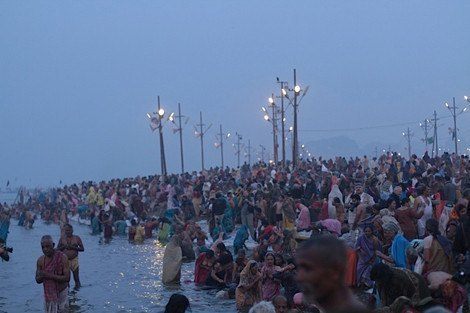February 12, 2013 — Tens of millions of people are gathering for the Kumbh Mela, a 55-day Hindu religious festival currently underway in Allahabad, India. The event happens every 12 years, with a massive temporary city constructed to accommodate worshipers seeking to bathe in the sacred waters of the Ganges and Yamuna rivers. It’s the largest single gathering on earth, and for researchers at Harvard School of Public Health it provides an unprecedented opportunity to gather the largest data set ever about a transient population.
The team of HSPH faculty members and students, which is coordinated and funded by the School’s FXB Center for Health and Human Rights, is documenting the outbreak and patterns of disease, the systems in place for water distribution and sanitation, and the methods for containing stampedes and mass casualties at the Kumbh, with a goal of strengthening understanding about public health concerns during mass gatherings and migrations.
This year’s festival, which began on January 14 and ends on March 10, was scarred by the deaths of 30 people killed in a stampede on February 10.
Under the direction of [[Jennifer Leaning]], Francois-Xavier Bagnoud Professor of the Practice of Health and Human Rights and director of the FXB Center, the team is led by Satchit Balsari, a fellow at the FXB Center and Harvard Humanitarian Initiative (HHI) and Gregg Greenough, director of research at HHI and an assistant professor at HSPH. The HSPH contingent is working with teams from Harvard’s Faculty of Arts and Sciences, Harvard Graduate School of Design, and Harvard Business School. The researchers are studying religious expression, temporary infrastructure, and the makeshift economy at the Kumbh, among other projects.
Already, the team has used information from more than 16,000 Kumbh clinic patients to produce a chart showing that more people are experiencing health complaints on one river bank than on the others, the New York Times reported in a February 8, 2013 article.
The team plans to incorporate this year’s stampede in their findings. In a blog post shortly after the incident, Balsari wrote, “The Kumbh Mela sees more resources, more planning, more implementation and more goodwill than any other large public project in India. It is tempting, very tempting, to therefore attribute the footbridge stampede to a freak but unfortunate accident that may scar the 2013 Mela forever. But to do so would be erroneous, for we believe that the footbridge accident is a symptom of a more pervasive malaise in the planning process, not unique to the Kumbh.”
“The Kumbh Mela festival takes place on a remarkable human scale. We expect that our findings will prove significant to the organizers of the Kumbh and more generally, will strengthen our understanding of the public health concerns of mass gatherings,” Leaning said.
Learn more
Follow the team on Twitter at #HarvardKumbh and on their blog.
Mapping India’s Kumbh Mela (The South Asia Institute at Harvard University)
Kumbh Mela resources (Harvard Global Health Institute)
Harvard doctors give Kumbh health facilities thumbs up (Times of India)
Can big data from epic Indian pilgrimage help save lives? (New York Times)
Mahakumbh 2013 becomes a subject of public health research for Harvard University students (India Today)
Mapping a megacity’s metabolism (Harvard Gazette)
Inside India’s pop-up city (Harvard Gazette)
